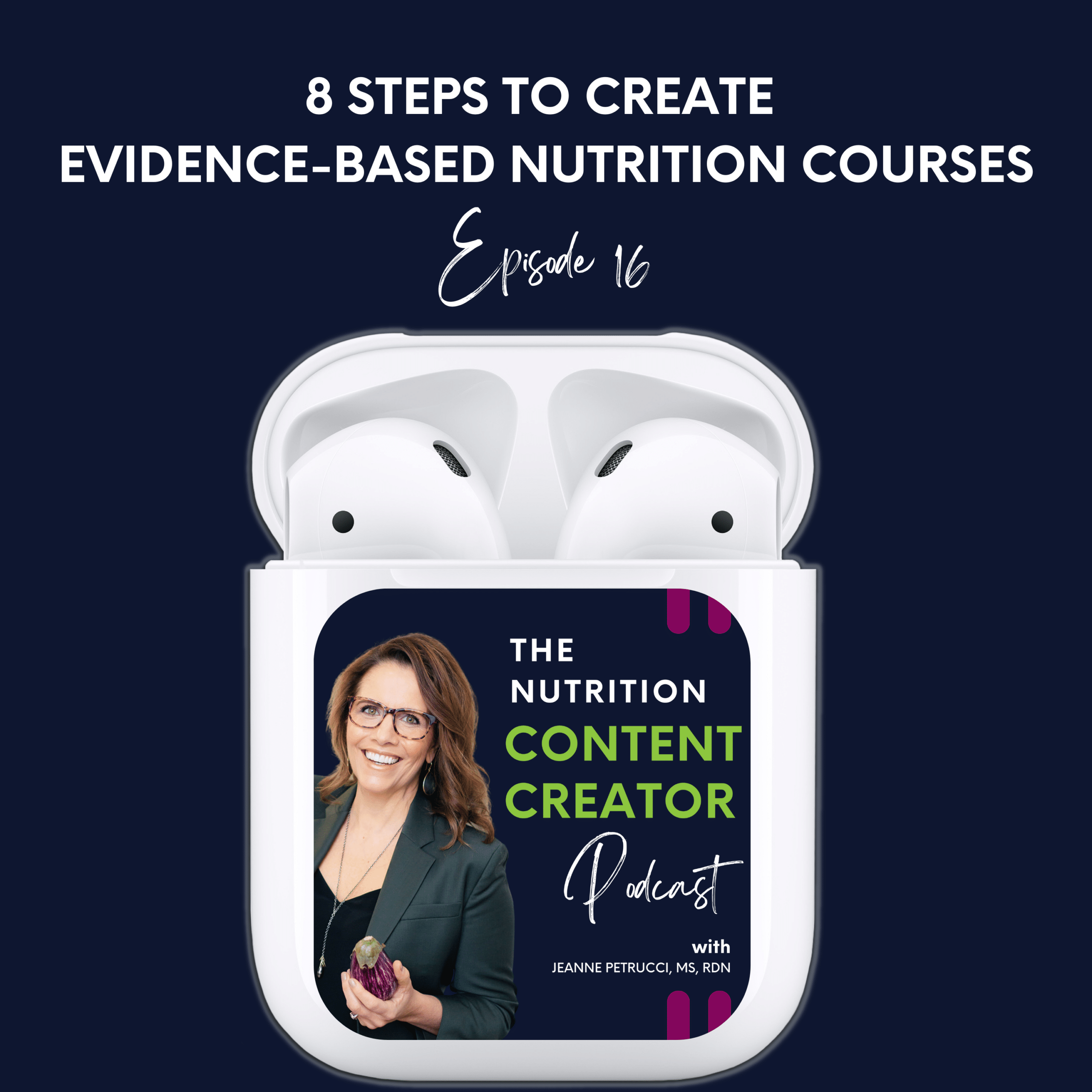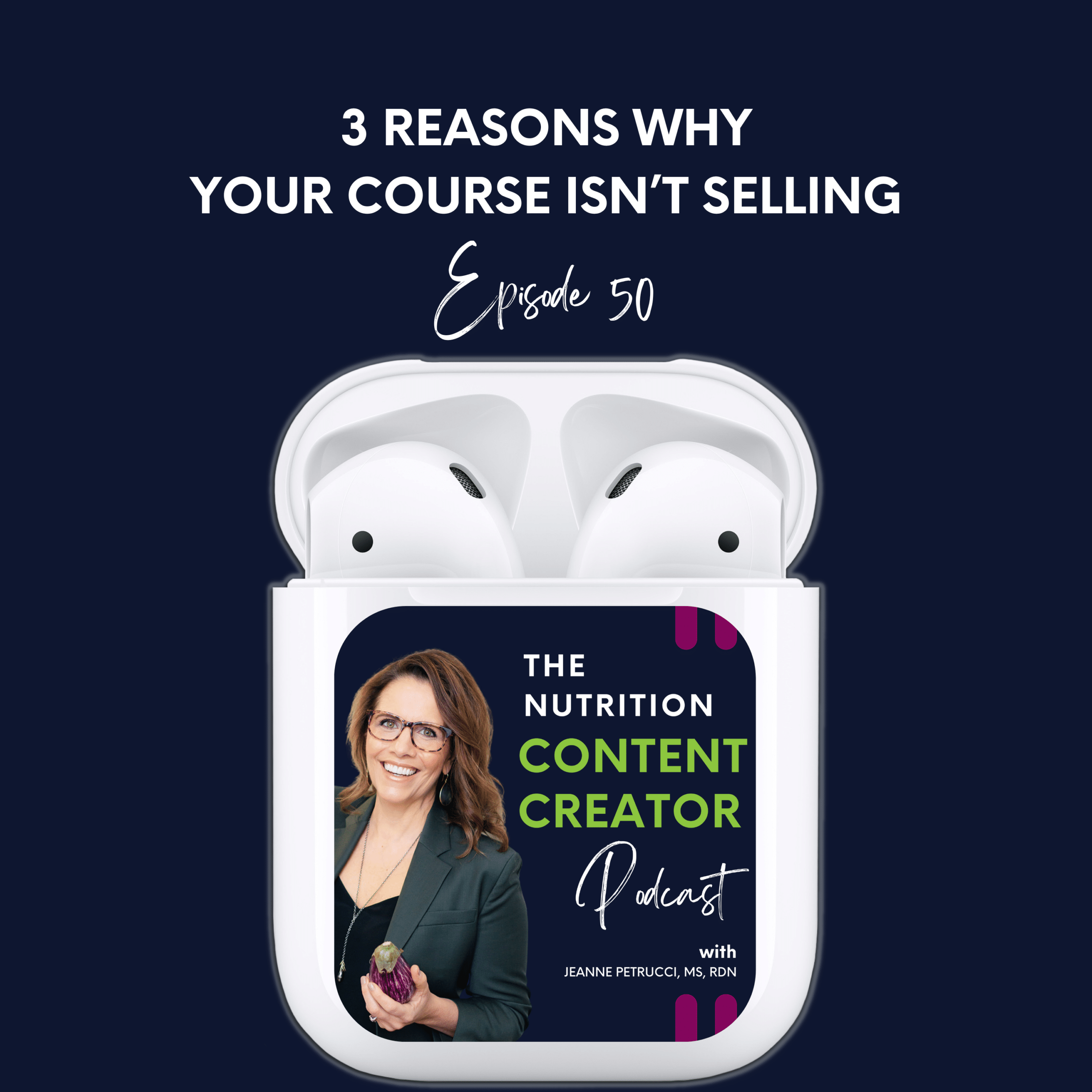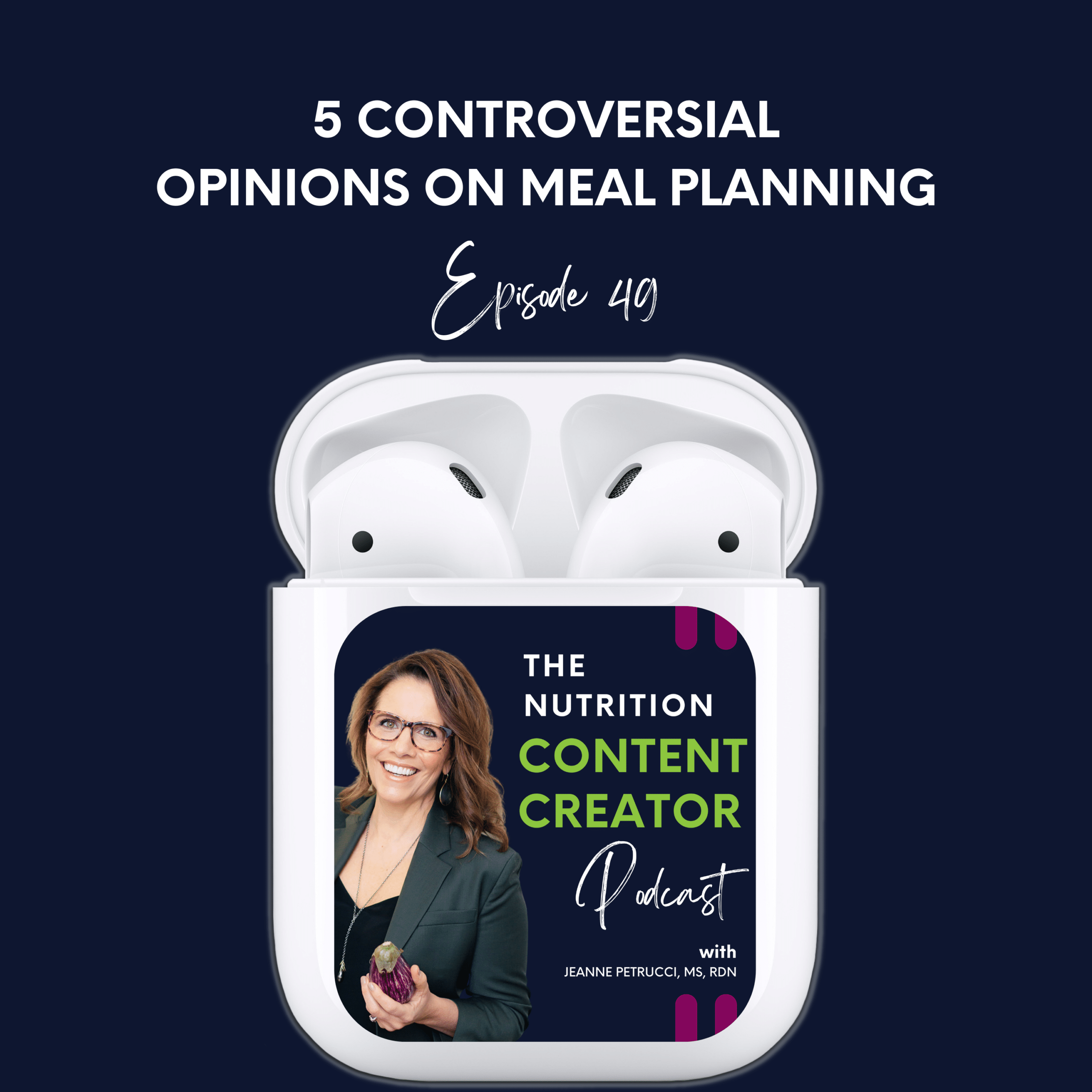16. 8 Steps to Create Evidence-Based Nutrition Courses

Building an evidence-based nutrition course is not the same as building a course that instructs students on cake decorating or how to paint horses. That’s why, even when colleagues take courses on “how to build a digital course” they still get hung up – because the content we work with is so unique it doesn’t always fit well into traditional course structures. If you build a course that only educates and provides “how-tos” it will be a tough sell.
You need to build a course that delivers an EXPERIENCE – one that takes your clients on a behavior-change journey to achieving an outcome you are promising and that they desire.
Today we are going to talk about the essential elements of an evidence-based nutrition course and how they come together to promote health behavior change.
We’ll cover:
- The 8-Step Course Framework for Building an Evidence-Based Nutrition Course
Step #1 Conduct an Assessment
On the counseling level, most of us are familiar with conducting individual client assessments. With courses that will be delivered to groups of people, you need to conduct a community assessment which will be a broader look at the community you serve. Conducting a community assessment allows you to identify the specific needs, interests, and challenges of your potential students for your course. You need to ask –
- Who are you creating this course for?
- What are their existing nutritional knowledge and skills?
- What are their most pressing health concerns or interests?
- What kind of transformation are they seeking from your course?
To answer these questions, it’s crucial to use a blend of methods. These might include surveys to gather broad feedback from current clients, interviews for deeper insights, and social listening on platforms where your target audience spends time. Remember, each method offers unique insights that can help paint a fuller picture of your potential students.
Here’s where many practitioners have a misstep – they create a course they know their ideal clients need but it’s not actually what they want. Confused? Let’s break it down.
From a marketing perspective, you don’t just want to create a course that your ideal customer avatar NEEDS, but rather, you want to create a course they WANT. That might seem like a small distinction, but it’s an important one.
Sometimes, as educators, we are inclined to build courses that we believe our students need. However, unless these courses also tap into something they want — a desire, a passion, a pain point — they might not resonate as strongly as we’d like and therefore will not sell.
People are often driven more by their emotional needs and desires than by logical ones. And in marketing, hitting those emotional chords can mean the difference between a course that’s ‘nice to have’ and one that’s a ‘must-have.’
The transformation that your course promises should be linked to the science supporting your community assessment, but it should also clearly identify and resonate emotionally with your audience. This is what will inspire and motivate potential students to enroll. It should be a clear, achievable result that aligns with the identified needs of your audience and hits an emotional chord.
For example, if you discover through your community assessment that your target audience struggles with balancing blood sugar levels and feels frustrated and overwhelmed, your course’s transformation could be: “gain the knowledge and skills to create nutritious, tasty meals that help manage blood sugar levels, enhancing your overall health and empowering you to regain control over your wellbeing.”
In this way, you’re not only addressing a health need (managing blood sugar levels) but also an emotional want (regaining control, reducing frustration). And that is the secret sauce of a successful, marketable course.
Step #2 Do Your Research
The one constant in our practices is that everything we teach should be grounded in evidence. The significance of this principle is amplified when it comes to building a culinary nutrition course. So, where should we start? The answer is simple yet substantial: with a comprehensive review of the most up-to-date research.
This process requires a deep dive into primary and sometimes secondary research sources. It’s about dissecting the most recent developments in the field and piecing them together in a coherent and meaningful way. Fortunately, for most of us, we have a niche and already have an excellent understanding of the research. But I encourage you to review current articles or visit webinars that present them so that you are up-to-date on research trends and evidence in your niche.
It’s important to remember that this research review isn’t simply an academic exercise, and it’s not about collecting intriguing facts or figures. Instead, it’s about understanding the broader context of the topic. This approach ensures that the advice we share is not only accurate and relevant but also truly beneficial to our learners, meeting them where they are in their health journey.
Whenever my team and I begin the research phase for any course we develop, we always expect to see patterns – so we are looking for them. During your research, you’re likely to start recognizing patterns — key pieces of information or “pillars” that continually emerge. These recurring themes or insights should be noted and considered carefully.
These pillars can serve as the backbone of your course. They provide a solid and reliable foundation on which you can build. And when they’re identified correctly, they can greatly enhance the overall strength and structure of your course.
These pillars might be certain dietary principles, cooking techniques, or behavioral strategies that are consistently supported by research. They are the non-negotiables, the must-haves, the key ingredients in the recipe for a successful course.
For example, when we were doing our research for the Nutrition and Detoxification Course, we kept noticing several recurring themes that set us up for structuring a course that addressed these six pillars:
Identify, Boost, Repair, Support, Personalize, Evaluate
We were then able to focus on each pillar, do a deeper dive, and craft modules for the course that not only delivered evidence-based education but delivered an EXPERIENCE that operationalized the concepts presented.
Here’s an example of how this works:
For the Boost pillar, we translated the science about what detoxification is and how you can optimize it with nutrition. We then provided culinary content that featured foods that boost the natural detoxification process so students felt confident taking action to boost their own detoxification processes.
So, while sifting through the research remember that what you’re really doing is unearthing the building blocks for your course.
Step #3 Create Actionable Objectives
While your course will certainly educate your students about your topic and how it impacts their health, learning is not an action.
Creating behavior-based objectives is where the rubber meets the road. It’s where you take all the data from your research review, and from those key pillars you’ve identified, and translate it into clear, measurable, actionable objectives for your course. This is where you transform the theoretical into the practical, turning EVIDENCE into ACTION.
Behavior-based objectives are specific actions or behaviors that your students should be able to perform by the end of the course, based on the evidence and pillars you’ve identified. And these aren’t just any behaviors. They’re the ones that, according to your research, will drive the health outcomes your students want to achieve.
For instance, let’s say one of the pillars you’ve identified in your research is the beneficial role of cruciferous vegetables in promoting detoxification. With this in mind, you might set an objective like: “By the end of the course, students will be able to plan and prepare at least five different meals per week that incorporate cruciferous vegetables.” This objective is clear (it states exactly what students should be able to do), measurable (you can count the number of meals), and directly tied to a behavior (planning and preparing meals).
With this objective, you know what comes next – you need to provide content that supports clients in achieving this goal. You don’t want to leave them high and dry to figure it out on their own.
Behavior-based objectives are not just a way to translate your pillars into practical steps; they’re a roadmap for your students, guiding them on their journey to achieving their health goals. They act as stepping stones, leading your students from where they are now to where they want to be.
And remember, each objective you set forms an integral part of the transformation your course promises. These objectives not only provide direction for your course content but they also give your students a clear picture of what they can achieve by taking your course. And this, my friends, is a powerful motivator.
So, as you draft your behavior-based objectives, think of yourself as a guide, leading your students on a path to improved health. Use the pillars you’ve identified as your compass, and be certain that each step is a well-defined, evidence-based, behavior-based objective that is measurable.
Step #4 Develop Your Content
Now that you’ve identified your key pillars and set clear, actionable course objectives, it’s time to take a deeper dive into each of these pillars. This step is all about developing your course’s heart and soul—its core content. But how do you do this?
Think back to the course objectives that you identified earlier. Each objective was tied to a specific behavior change that supports your overall course transformation goal. Now, as you move into developing content for each pillar, those objectives become your guideposts. They’ll help you decide what content to include and how to structure your modules.
Each pillar in your course should have 3-4 specific, actionable objectives tied to it. These objectives serve as mini-goals for each module, guiding your students through their learning journey and ensuring they make progress toward the overall transformation. For instance, if one of your pillars is centered on boosting your body’s own detoxification process, your objectives might be things like “Shop for key foods that support detoxification,” “Apply knowledge of the role these foods play in supporting detoxification to the preparation of meals,” “Create a weekly meal plan incorporating detoxifying foods,” and so forth.
By assigning specific objectives to each pillar, you’re creating a clear, structured learning path for your students. They’ll know exactly what they’re supposed to learn and do in each module, which makes the learning experience more manageable and less overwhelming.
So, for each pillar, start by defining your objectives. Then, build your content around these objectives. Start by laying a solid foundation of knowledge. Then, dive into the details. Include practical application strategies and make the content engaging and digestible. Use visuals, interactive elements like video, and real-world examples to bring your content to life.
Remember, as a course creator, your aim isn’t just to educate—it’s to inspire action. This isn’t a textbook, it’s a roadmap to better health. Your objective-aligned pillars are the stepping stones on this journey, guiding your students toward their ultimate transformation goal. You are equipping your students with the TOOLS they need to put that KNOWLEDGE into ACTION. And that is where real transformation happens.
Step #5 Create an Evaluation for Each Module
“You can’t change what you can’t measure.”
This quote holds particularly true when you’re designing an educational course. Without a robust evaluation system in place, it’s impossible to gauge whether your course is effective, if your learners are absorbing the information, or if they’re able to take action on their newfound knowledge in their daily lives. Therefore, an essential part of your course design process should be creating a thorough evaluation for each module.
These evaluations aren’t just for you—they’re also for your students. Feedback is a powerful tool for learning and growth. By setting up a system of regular, structured assessments, you provide your students with valuable feedback on their learning progress. This allows them to identify areas of strength, understand where they may need to invest more effort and celebrate their progress, all of which can significantly enhance their learning experience and support behavior change.
How to create evaluations
There’s no one-size-fits-all answer, but the best approach is one that aligns with the objectives of each module. Remember those behavior-based objectives you identified for each pillar in your course? These are your guideposts for designing your evaluations. Your goal is to create assessments that not only measure understanding but also evaluate whether the learner can put their knowledge into action.
This could mean designing quizzes that test knowledge retention, creating reflective assignments and prompts that ask students to apply what they’ve learned to their own lives, or setting up discussion forums where learners can engage with the material (and each other) in a more interactive way. You might also consider practical assignments, especially for a culinary nutrition course—after all, what better way to evaluate if a student can create a meal plan based on their nutritional knowledge than having them actually do it?
Creating effective evaluations requires careful thought and planning. The goal isn’t to make students feel inadequate. The purpose of these evaluations is to reinforce learning, provide a means for tracking progress, and offer insights that help your students apply the course material in meaningful, practical ways.
So, as you create your course modules, remember to build in robust, objective-aligned evaluations. By doing this, you’re not just teaching your students—you’re empowering them to learn, grow, and most importantly, to measure and celebrate their progress, creating a truly transformative learning experience.
Step #6 Create Culinary Nutrition Materials
Combining nutrition education with hands-on or observational culinary experience is what sets a culinary nutrition course apart from other nutrition education programs. The key is to create culinary content that aligns with the nutrition education presented in each module, effectively bringing together theory and practice. When well executed, this integrated approach ensures that your students don’t just understand the ‘why’ behind their nutritional recommendations—they also master the ‘how’ of implementing them into their everyday lives.
Consider each module’s core educational concepts—these are usually based on the ‘pillars’ you identified during your initial research. With these pillars in mind, ask yourself, “How can I help my learners operationalize this concept in their daily lives?” The answer to this question will guide your selection of culinary content.
For instance, if a module is focused on the benefits of fiber, you would want your culinary content to show students how to incorporate more fiber-rich foods into their diets. This could mean providing cooking videos demonstrating how to prepare high-fiber meals, offering a recipe book featuring fiber-rich recipes, or giving tips on meal planning and shopping to optimize fiber intake.
Alongside this, creating accompanying nutrition and culinary materials will reinforce learning and provide learners with tangible resources they can use long after the course has ended. These materials might include handouts that summarize the nutritional information for each module, step-by-step cooking guides, shopping lists tailored to each module’s focus, and meal planning templates like The Mealtime Method explained in Episode #14. All these materials aim to bridge the gap between theory and practice, making it easier for students to apply their newfound knowledge in their own kitchens.
Step #7 Build in Goal Setting
The journey of health behavior change is a lot like rock climbing. It’s not a leap to the top, but a series of carefully planned, strategic moves. Each move is significant and brings the climber closer to the summit, yet it requires effort, precision, and perseverance.
If you have ever been rock climbing, you know you make decisions with each move and have to consider, “Is this the right next move to advance me up the wall or mountain? Maybe it’s too far a reach or perhaps it can be easily reached. Similarly, in the context of your course, each module should be designed as a strategic ‘move’ that is doable and helps your students progress towards their overall health goals.
Just as rock climbers set smaller, attainable targets on their way to the summit, your learners should be guided to set specific, achievable goals within each module. Many practitioners use S.M.A.R.T. goals – this stands for Specific, Measurable, Attainable, Relevant, and Time-Bound. The S.M.A.R.T. goals framework guides your students to create goals that can be measured and consider where they are in their behavior change journey.
S.M.A.R.T. goals might be: “I am going to make a chia pudding recipe from my meal plan this week for breakfast.” Or “I am going to make the pears with nut butter and hemp seeds for a snack on Weds.” These goals fit the framework and would be appropriate for someone who is busy, maybe lacks culinary confidence, and is just started their health journey.
Incorporating goal setting within each module of your course transforms the learning experience from a passive to an active one. It empowers your students to take charge of their health, making them active participants in their journey towards better nutrition and wellness, rather than passive recipients of information.
This strategy provides a scaffolded learning experience. As your learners meet each small goal, they build confidence and motivation, leading to a positive cycle of engagement and achievement. The series of small successes also generates momentum, making it more likely they will stay on track toward reaching their larger health goals.
Step #8 Marketing Your Course
You could build the most FABULOUS digital course on the market but if proven sales and marketing strategies are not applied it will be crickets for your practice.
As we wrap up today’s episode, I have an exciting opportunity for you that I don’t want you to miss. If today’s discussion about creating a transformative, evidence-based culinary nutrition course has sparked your interest, I want to invite you to join me for a FREE recorded two-day workshop. This workshop will offer a comprehensive look at not only building a high-quality digital course but also effectively marketing it.
This two-day event is called “Revolutionize Your Practice with Evidence-Based Digital Courses: A Practical Workshop for Dietitians” and enrollment is now open! If you are not a dietitian, but are a healthcare or wellness professional interested in unlocking the power of digital courses for your practice, then you are also welcome to register for the recording.
On Day One we will operationalize everything we talked about today, giving you actionable strategies you can implement to create an evidence-based digital course. We’ll also dive into how digital course components fulfill the nutrition care process, known as A.D.I.M.E.
On the second day, we’ll turn our attention to the art and science of Digital Course Marketing. I have partnered with Stephanie Hofhenke, a marketing expert for nutrition professionals, who will join us to unpack what it takes to make digital courses a major driver of your practice growth. We’ll explore customer-centric solutions, learn how to create irresistible calls to action, craft persuasive landing pages, and determine the perfect client attraction strategy.
Remember, creating a digital course is about much more than just sharing knowledge. It’s about creating an engaging, practical, and effective learning experience that fosters positive health behavior change and scales your brand.
Whether you’re in the early stages of contemplating a digital course or looking to optimize an existing one, this workshop is designed to provide you with the necessary tools and insights.
So, don’t wait! Click on the “Register ” button in the show notes to grab your recording of this two-day event and start your journey toward creating a transformative and successful digital course.

Your Content Cure for This Week
Your Content Cure for this week is to register for the workshop.
>> REGISTER FOR THE WORKSHOP HERE<<
Key Takeaways
Let’s summarize our conversation today about using an evidence-based approach to digital course creation:
- Conduct a Community Assessment: Understanding your Ideal Customer Avatar (ICA) is the first step. Engage with your community, and identify their needs, interests, and challenges to tailor your course to their unique needs and goals.
- Start with the Evidence and a Research Review: The importance of conducting a comprehensive research review to understand the latest developments in the field of nutrition. This step ensures that your course content is accurate, relevant, and beneficial.
- Create Behavior-based Objectives for the Course: Translating the knowledge obtained from the research review into clear, measurable, and actionable objectives, which will serve as the backbone for your course content.
- Take a Deeper Dive into Each Module: Each pillar or theme identified from your research should have its comprehensive nutrition education content. Each module should have 3-4 actionable objectives that tie back to the course objectives.
- Create an Evaluation for Each Module: Stressing the importance of having an evaluation system in place to assess the learners’ understanding of the material, and ensuring the objectives set are measurable.
- Select Culinary Content that Aligns and Create Nutrition and Culinary Materials: Complementing the educational content with practical culinary content and creating additional materials that align with each module’s objectives. All these elements should aim at bridging the gap between theory and practice.
- Build-in Goal Setting: The importance of incorporating goal setting into each module to help learners apply their knowledge and track their progress.
- Participate in Workshop: Invitation to join a two-day workshop that goes in-depth into the creation and marketing of digital courses. The workshop covers creating evidence-based nutrition course frameworks, effective digital marketing strategies, and much more.

Jeanne Petrucci MS RDN
Founder, Expert Nutrition Content Creator


